52 Weeks of Fantastic Bindings: Week 6
Two of the earliest St Andrews bindings: The St. Leonard’s Chained Bible and a 1501 copy of Jacques Lefèvre d’Etaples’ commentary on Aristotle
This week’s Fantastic Binding is, again, a double bill; only this time we are showing off a set of very old twins. St Andrews has very few early St Andrean bindings, and these are two of the most interesting: a 1511 Rouen printing of the Vulgate Bible and a 1501 Parisian printing of Jacques Lefèvre d’Etaples’ commentary on Aristotle. Both of these items are bound uniformly in an early 16th century stained calf over oak boards, featuring a blind panel stamp of the Crucifixion. This stamp is believed to be the earliest example of Scottish panel binding and also a very early example of fleur-de-lis stamped corners being used in Scotland.
- Front cover of the 1511 chained Bible that is believed to be the foundation Bible for St. Leonard’s College.
- Detail of two pages of 2 Chronicles from Bib BS75.B11.
- Signature of Robert Wilkie, principal of St. Leonard’s College 1589-1611, and date “1604” on the front paste-down of Bib BS75.B11.
- Bib BS75.B11 and TypFP.B01HF side-by-side for comparison.
- Front board of the 1501 copy of Jacques Lefèvre d’Etaples’ commentary on Aristotle, TypFP.B01HF.
- High contrast detail of the blind panel stamp from the front board of TypFP.B01HF, a Crucifixion scene with Mary and St. John kneeling.
- High contrast detail of the blind-stamped fleur-de-lis corner stamps of TypFP.B01HF.
- Front fly-leaf of TypFP.B01HF, with the signatures of James and Robert Wilkie, father and son, both principle’s of St. Leonard’s College.
The 1511 Vulgate Bible, currently on display at MUSA, is believed to be the foundation Bible for St. Leonard’s college. This is based on the date of the foundation of St. Leonard’s (1511) and an ownership inscription of Robert Wilkie, principal of St. Leonard’s College 1589-1611, found on a fragment of a contemporary fly-leaf. It is also a fine example of a 16th century chained book, with a metre of its contemporary chain, including swivel-hinge, still intact. Lefèvre’s commentary on Aristotle bears the inscription of Robert Wilkie as well, but also has the inscription of his father, James Wilkie (also an early principal of St. Leonard’s), and the names of Gilbert and Robert Winram, two even earlier students at St. Leonard’s.
It is very possible that both of these items were bound in St Andrews. The evidence for this is mainly based on old binding waste found that has St Andrews’ provenance as well as the provincial style that these both were executed in. Both items feature a crude panel stamp of the Crucifixion, with what are probably Mary and St. John kneeling. BibBS75.B11 has this panel stamp only on the front board, while TypFP.B01HF has this scene on both boards. Both items place the panel within a double blind fillet frame with blind stamped fleurons along the borders and with blind stamped fleur-de-lis at corners. TypFP.B01HF has the remains of two contemporary clasps and is sewn on four raised bands, while BibBS75.B11 has evidence of one central clasp (along with the contemporary chain) and is sewn on five bands. It has been suggested that these books were bound in St Andrews Priory based on their similar structure to another book of certain Priory provenance and on St. Leonard’s close ties with the Priory in the 16th century.
These bindings were almost certainly done before 1560, as a Crucifixion scene on anything would have been subject to destruction after the Reformation, and almost certainly done within the first quarter of the 16th century as Gilbert Winram died in 1530. Viewing these items side-by-side, it is obvious that they were made by the same hand and probably near the same time. The placement of tools and the type of calf and boards used are identical.
–DG
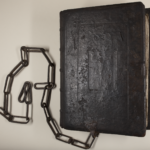
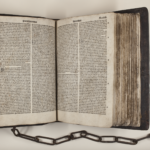
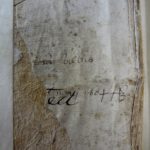
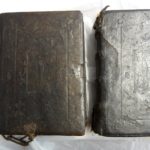
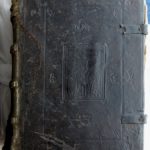
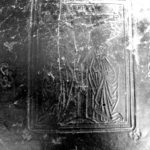
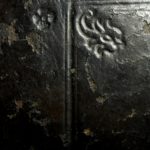
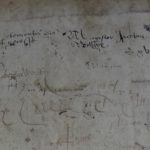
[...] Library ← 52 Weeks of Fantastic Bindings: Week 5 52 Weeks of Fantastic Bindings: Week 6 → 20/07/2011 · 10:28 am ↓ Jump to [...]
[...] early St Andrean binding. This binding, in many ways, is possibly even more interesting than the two early panel stamped bindings featured in week 6’s post, although they share some similarities. #gallery-1 { margin: auto; } #gallery-1 .gallery-item { [...]